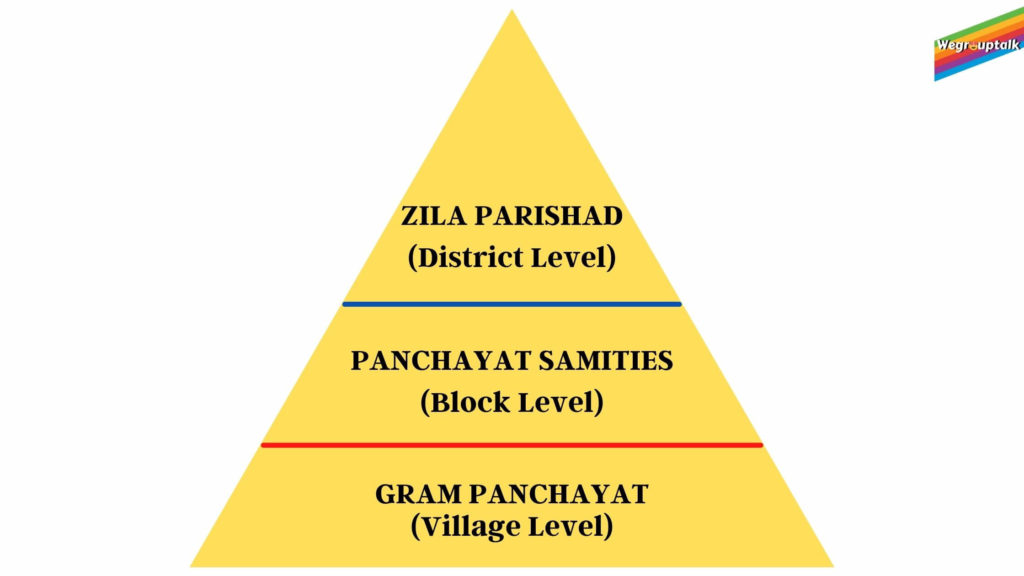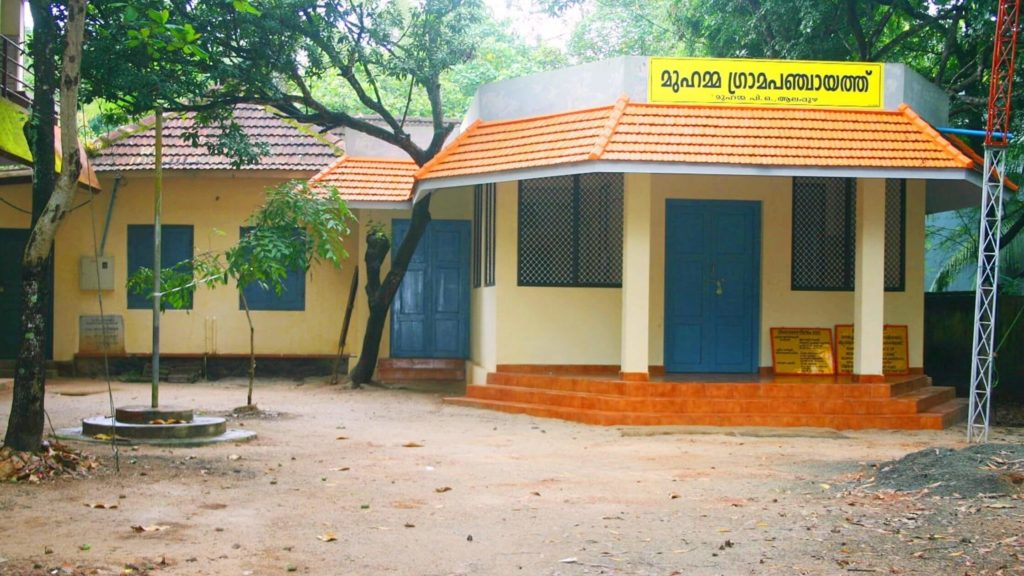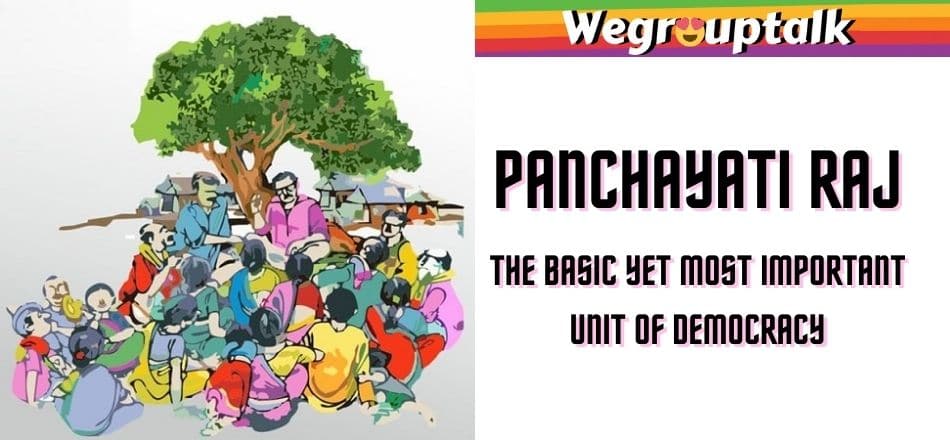According to the Hindu epic Mahabharata, “Gramik” was the chief of a village, and “Shat Gram Adhyaksha” was the chief of 100 villages. The idea of local self-governance has its roots in the epic era. The villages were divided into units(10, 50, 100, or even 1000). The heads of these villages were expected to collect taxes from the villagers and, in return, provided security.
They acted as King’s liaison and brought issues pertaining to the villages to King’s notice. Even in the Rig-Veda, the is a mention of ‘Sabha,’ an elected body to look after village affairs. Similarly, there are also local bodies that have occupied space in Chanakya’s Arthshastra. The village chief was called ‘Nagarik,’ and the elected body was free from royal interference.
Hence, we can say that the idea of local self-governance is not a novel idea, but it has a long history in the South Asian subcontinent.
What is Panchayati Raj?
Panchayati Raj is a system of rural self-governance in India. In this institution, the local bodies are elected by the people and hold authority over the indigenous affairs. This system was constitutionalized in 1992 as a step to the decentralization of power in a democracy. There are 29 subjects listed in the 73rd Constitutional Amendment Act, which elaborates this institution’s objectives.
These include “agricultural extension, land development, rural electrification, education, primary health centers, women and child development, and others.” The Panchayati Raj exists in all states except in Meghalaya, Nagaland, and Mizoram. The word Panchayat is derived from two words, “Pancha” means five, and “ayat” means the rule. Hence, it means a rule of five people.
The term of each Panchayat ends after five years, and the elections are held within six months after the council is dissolved. Every person over 18, irrespective of class, caste, and gender, has the right to vote. The nominees must be registered on the electoral rolls as voters.
There is a special reservation for SC, ST, and OBC in proportion to their population in that region. One-third (33%) of all the seats are reserved for women.
Three Tier structure of Panchayati Raj
Article 40 of the Indian constitution directs The State to organize village panchayats and endow them with powers. Part IX of the Indian Constitution states that the states and union territories with more than 2 million inhabitants will have three levels of Panchayati Raj institutions.

The Gram Panchayat at the Village Level
It is the basic unit of village self-governance, which five Gram Sabhas form. The Gram Sabha elects the members of the Gram Panchayat. The Gram Sabha consists of a single village council which is the basic-most unit of Panchayati Raj. According to data by the Government of India, there is a total of 253268 Gram Panchayats.
The Panchayat Samiti at Block Level
It is a panchayat body that works at a Tehsil(Block) level. It consists of elected members of the area by the Panchayat, members from other associations, stakeholders from an ST/SC community, and a block development officer. The presiding officer is called Block Pramukh. It collects data about the gram panchayat plans and then takes them to Zila Parishad to extract funding for those plans to be executed. It also looks at the issues that must be addressed at the block level. The Samiti acts as a bridge between Gram Panchayat and Zila Parishad.
The Zila Parishad at the District level
It is the third tier of the Panchayati Raj Institution. They access the 5-year development plan of the Block and provide resources to execute them. It oversees the development projects of the rural areas. The members include Panchayat Samiti members, Member of Parliament representing that region, Member of Legislative Assembly of that district, and Chief Executive Officer who is an IAS officer.

Panchayati Raj During British Era
After the British colonized India, the local self-governance institutions got disbanded. The local authorities became weak. After the revolt of 1857, the British faced heavy financial constraints which could only be overcome by collecting taxes from the villages. This brought the resurgence of local administration.
The Mayo’s Resolution
The colonizers introduced Mayo’s resolution of 1870. It aimed to develop local self-governance bodies and decentralization of political and financial power of the state or a province. Local municipalities and district boards were established to manage the “funds devoted to education, sanitation, medical relief and local public works” as per guidelines of Mayo’s resolution.
In other words, it was a great way to collect taxes from the people and establish communication between various departments.
Ripon’s Resolution of 1882
This was followed by Ripon’s Resolution of 1882, which democratized the institution to a certain degree. The committee had the majority of elected non-officials who were elected, and the chairman was from among the non-officials. The objective was to reduce the central interference to a minimum and provide freedom to the body for dealing with local affairs.
But, the elected members were always in the minority, and the central government still exercised absolute power over these bodies. Even the local representation of Indians in these bodies was the bare minimum. The lack of financial support to the local bodies was a major stumbling block for effective governance.

Royal Commission on Centralisation of 1907
Colonial support to the local bodies was a major stumbling block for effective governance. These issues under Rippon’s resolutions were attempted to be tackled with the Royal Commission on Centralisation of 1907 under CEH Hobhouse’s leadership.
This commission underlined the importance of Panchayat at the village level and pointed out the dearth of financial support to these institutions. It even entrusted them with more powers, but those recommendations remained only in the outlines of a paper, and the conditions of the local administration didn’t witness any significant change.
The Resolution of May 1918
The Resolution of May 1918 re-examined the discussion around local self-governance. It proposed that the people must represent the bodies, and they must be granted higher powers to extract tax revenue without restrictions or budget constraints. The resolution even expressed the importance of Panchayats and declared them not just an adjunct to municipalities but also an important part of village development.
Government of India Act, 1919 and the introduction of Dyarchy
The government of India Act, 1919 allowed provinces to establish local self institutions, but lack of finances hindered their development, which The Simon Commission noted. GOI Act 1919 introduced the double government system call Dyarchy where autonomy was relegated to provinces, but some subjects fell into one of the executive branches controlled by the Crown-appointed Executive Councillors.

The subjects under those were termed as ‘reserved,’ and finance was one of them. Hence, the local administration was devoid of funds to develop themselves. Local self-governance was included in “transferred” subjects controlled by ministers chosen from the provincial legislature’s elected members.
The Government of India Act, 1935 gave impetus to the development projects and boosted the provinces’ autonomy. Many laws were passed, which gave more power to the elected ministers, and the financial demarcations got blurred. But, the state of local bodies remained the same until India’s independence in 1947, thanks to the leaders’ ignorance.
Post-Independence Panchayati Raj Institution
Post Independence, our nation’s leaders like Pandit Jawahar Lal Nehru and Mahatma Gandhi envisioned a welfare state based on the principles of Democratic socialism. Gandhi remained at the forefront to advocate the idea of decentralization of power.
He termed it as “Gram Swaraj,” where small villages would be responsible for their own affairs. The state of Bihar passed Bihar Panchayati Raj Act 1947, which came into operation in 1949. The act was the extension of the form of local governance introduced by Lord Rippon. But, since then, the act has undergone several amendments.
However, Rajasthan became the first Indian state to introduce Panchayati Raj post-independence on 2nd October 1959 in Nagaur District. Andhra Pradesh also followed in the footsteps. These Panchayats were not evenly extended to all parts of India because these were funded and implemented by the state and not by the Center.
Various Committees and their Recommendations
Being a young republic, India was ignoring the rural development, which only a few financial hubs like Bombay, Delhi, and Calcutta saw disproportionate development than the rest of the country. Finally, in 1957, the Government of India formed Balwant Rai Mehta Committee to suggest measures to improve the Community Development Program’s work (1952) and National Extension Service(1953).
1. Balwant Rai Mehta Committee
It recommended the establishment of the Panchayati Raj System at three levels and the members of the Panchayat being directly elected by the people. It also talked about the distribution of power to these bodies and defined all three tiers’ roles. The three tiers being Gram Panchayat, Panchayat Samiti, and Zilla Parishad.
It presented that the Panchayat must work under the supervision of Samiti. It also spoke of providing adequate training to the elected representatives. These recommendations were accepted in 1948 NDC, and the term coined was Panchayati Raj Institution.
2. V.T. Krishnamachari Committee(1960)
It recommended the administrative and technical services in the Panchayati Raj Institution. It proposed that the administrative officers of a particular area must assist all three tiers of this institution in preparing a technically sound plan in alignment with the government policies.
3. Ashok Mehta Committee(1978)
It suggested the government include Panchayati Raj in the Indian Constitution. It even recommended the states with Panchayati Raj, like West Bengal, Andhra Pradesh, Karnataka, etc., to make amendments in their local self-governance system to be in alignment with the structure suggested by the Balwant Rai Mehta Committee. Hence, these states undertook several steps to empower these institutions.
4. G.V.K Rao Committee(1985)
This committee recommended that a District should be made the basic unit of planning. The District members (Zilla Parishad) must supervise the co-ordination between Panchayat Samiti and Gram Panchayat. Each district should be given a certain amount to carry out development activities within their allotted constituencies.
It is also recommended to hold regular elections of Panchayat in an interval of five years and lay down details for a Gram Sabha dissolution.
5. L.M.Singhvi Committee(1986)
Rajiv Gandhi appointed the committee to revitalize the Panchayati Raj Institutions “for Democracy and Development.” It is recommended to give constitutional recognition to these institutions and strengthen them with sufficient financial support.
It advised the government to add a new chapter to the constitution(9th chapter). It even suggested establishing Nyaya Panchayat for a cluster of villages.
6. P.K.Thungan Committee(1989)
It is recommended that the Zilla Parishad should play a key role in planning and development. The committee reiterated to provide constitutional status to PRIs and regular election at the local level.
73rd Constitutional Amendment(1992)
Finally, in December 1992, 73rd and 74th amendments were passed in the parliament to grant constitutional legitimacy to local self-governance in Rural and Urban India. The amendment and the modern Panchayati raj system’s implementation then got extended to states like Himachal Pradesh, Gujarat, Maharashtra, Odisha, etc.
The system has its flaws, and even after the 73rd amendment, we see various committees being formed to tackle the pertaining issues—one of them being the S.Mohinder Singh Committee of 2013.
The Panchayati Raj institution is an emblematic representation of Democracy at the very grass root level. It allows the people living in the village to have a development which goes in hand with the culture. It provides them autonomy and freedom to decide for themselves as well as the welfare of those around them. Panchayati Raj is the way to check the centralization of power and permits people to be participants rather than spectators.
Follow us on FACEBOOK, INSTAGRAM, and TWITTER to stay connected.
Also, Read- How India can become a superpower?




